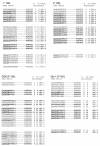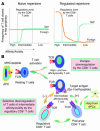An affinity/avidity model of peripheral T cell regulation
- PMID: 15668735
- PMCID: PMC544609
- DOI: 10.1172/JCI23879
An affinity/avidity model of peripheral T cell regulation
Abstract
We show in these studies that Qa-1-dependent CD8+ T cells are involved in the establishment and maintenance of peripheral self tolerance as well as facilitating affinity maturation of CD4+ T cells responding to foreign antigen. We provide experimental evidence that the strategy used by the Qa-1-dependent CD8+ T cells to accomplish both these tasks in vivo is to selectively downregulate T cell clones that respond to both self and foreign antigens with intermediate, not high or low, affinity/avidity. Thus, the immune system evolved to regulate peripheral immunity using a unified mechanism that efficiently and effectively permits the system to safeguard peripheral self tolerance yet promote the capacity to deal with foreign invaders.
Figures





References
-
- Kappler JW, Roehm N, Marrack P. T cell tolerance by clonal elimination in the thymus. Cell. 1987;49:273–280. - PubMed
-
- Bouneaud C, Kourilsky P, Bousso P. Impact of negative selection on the T cell repertoire reactive to a self-peptide: a large fraction of T cell clones escapes clonal deletion. Immunity. 2000;13:829–840. - PubMed
-
- Kuchroo VK, et al. T cell response in experimental autoimmune encephalomyelitis (EAE): role of self and cross-reactive antigens in shaping, tuning, and regulating the autopathogenic T cell repertoire. Annu. Rev. Immunol. 2002;20:101–123. - PubMed
-
- Jiang H, Chess L. The specific regulation of immune responses by CD8+ T cells restricted by the MHC class IB molecule, Qa-1. Annu. Rev. Immunol. 2000;18:185–216. - PubMed
Publication types
MeSH terms
Substances
Grants and funding
LinkOut - more resources
Full Text Sources
Other Literature Sources
Research Materials

